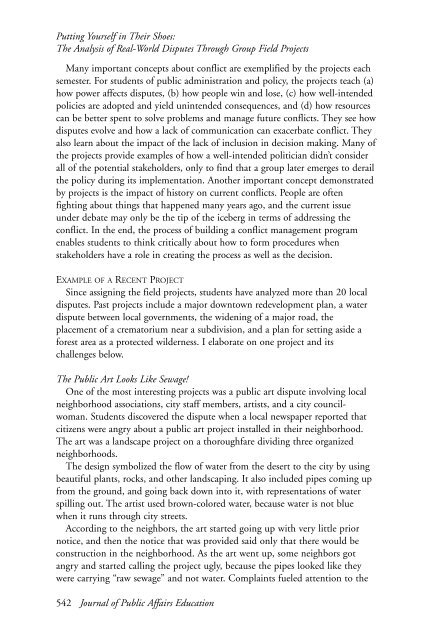JOURNAL OF PUBLIC AFFAIRS EDUCATION - National ...
JOURNAL OF PUBLIC AFFAIRS EDUCATION - National ...
JOURNAL OF PUBLIC AFFAIRS EDUCATION - National ...
Create successful ePaper yourself
Turn your PDF publications into a flip-book with our unique Google optimized e-Paper software.
Putting Yourself in Their Shoes:<br />
The Analysis of Real-World Disputes Through Group Field Projects<br />
Many important concepts about conflict are exemplified by the projects each<br />
semester. For students of public administration and policy, the projects teach (a)<br />
how power affects disputes, (b) how people win and lose, (c) how well-intended<br />
policies are adopted and yield unintended consequences, and (d) how resources<br />
can be better spent to solve problems and manage future conflicts. They see how<br />
disputes evolve and how a lack of communication can exacerbate conflict. They<br />
also learn about the impact of the lack of inclusion in decision making. Many of<br />
the projects provide examples of how a well-intended politician didn’t consider<br />
all of the potential stakeholders, only to find that a group later emerges to derail<br />
the policy during its implementation. Another important concept demonstrated<br />
by projects is the impact of history on current conflicts. People are often<br />
fighting about things that happened many years ago, and the current issue<br />
under debate may only be the tip of the iceberg in terms of addressing the<br />
conflict. In the end, the process of building a conflict management program<br />
enables students to think critically about how to form procedures when<br />
stakeholders have a role in creating the process as well as the decision.<br />
EXAMPLE <strong>OF</strong> A RECENT PROJECT<br />
Since assigning the field projects, students have analyzed more than 20 local<br />
disputes. Past projects include a major downtown redevelopment plan, a water<br />
dispute between local governments, the widening of a major road, the<br />
placement of a crematorium near a subdivision, and a plan for setting aside a<br />
forest area as a protected wilderness. I elaborate on one project and its<br />
challenges below.<br />
The Public Art Looks Like Sewage!<br />
One of the most interesting projects was a public art dispute involving local<br />
neighborhood associations, city staff members, artists, and a city councilwoman.<br />
Students discovered the dispute when a local newspaper reported that<br />
citizens were angry about a public art project installed in their neighborhood.<br />
The art was a landscape project on a thoroughfare dividing three organized<br />
neighborhoods.<br />
The design symbolized the flow of water from the desert to the city by using<br />
beautiful plants, rocks, and other landscaping. It also included pipes coming up<br />
from the ground, and going back down into it, with representations of water<br />
spilling out. The artist used brown-colored water, because water is not blue<br />
when it runs through city streets.<br />
According to the neighbors, the art started going up with very little prior<br />
notice, and then the notice that was provided said only that there would be<br />
construction in the neighborhood. As the art went up, some neighbors got<br />
angry and started calling the project ugly, because the pipes looked like they<br />
were carrying “raw sewage” and not water. Complaints fueled attention to the<br />
542 Journal of Public Affairs Education

















